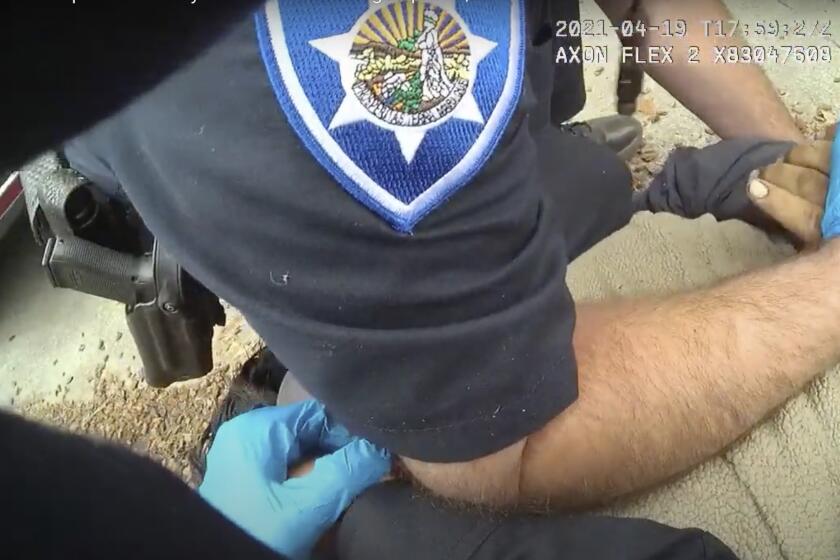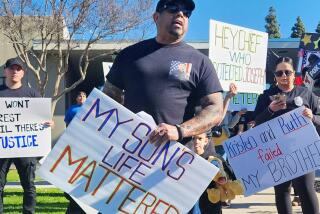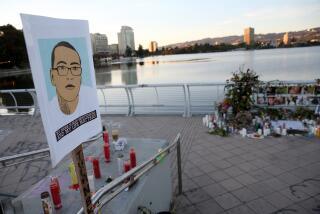Video showing officer’s knee on Mario Gonzalez’s back before he died alarms experts

Several law enforcement use-of-force experts have expressed deep concerns about a body camera video that shows an Alameda police officer appearing to put a knee on the back of a 26-year-old Latino man for more than four minutes as he gasped for breath and eventually died.
The case is generating widespread outrage and has sparked investigations, with the family of Mario Gonzalez saying he posed no threat to officers and there was no reason to pin him down for so long.
Gonzalez’s cause of death is still under investigation, but several experts in police training contacted by The Times said Gonzalez could have been asphyxiated by the officer’s knee.
It’s a video that has drawn comparison to that of the George Floyd killing.
The experts
Seth Stoughton, a University of South Carolina law professor and a former Florida police officer, said “the dangers of positional asphyxia” have been well known in policing and incorporated into training since the early 1990s.
The technique of pinning a suspect to the ground should especially be avoided when there are risk factors, such as obesity or drug or alcohol use, as was true in the Alameda case, Stoughton said.
He likened the situation to a boa constrictor killing its prey by depriving it of oxygen.
Stoughton, who has written about police training and force extensively, said it is acceptable for officers to place someone prone on the ground for a short period of time to put handcuffs on them.
But there was no need to pile on Gonzalez to arrest him, Stoughton said.
Ed Obayashi, a Northern California sheriff’s deputy, legal advisor and veteran police trainer, agreed.
“It is rare that a nonthreatening, nonbelligerent person ends up dying like this. ... What was the officers’ justification for detaining him? This individual was not a threat to the officers,” he said.
“This is another tragic incident of compression asphyxia,” Obayashi said. “Officers have to be able to recognize compression asphyxia. We have had too many deadly incidents like this one.”
Another expert took a different view.
Charles “Sid” Heal, a former Los Angeles County sheriff’s commander and use-of-force expert, said he did not see a problem with the officers’ actions.
“The suspect is in a continual state of resistance and defiance,” Heal said. “The officers actually plead with him not to resist. I suspect he is under the influence of some drug and is going to die from either the drug or excited delirium.”

The 911 calls
Alameda police were sent to a local park on April 19 in response to calls about an intoxicated man and a possible theft.
One of the 911 callers told a dispatcher: “He seems like he’s tweaking. But he’s not doing anything wrong, he’s just scaring my wife.”
A second caller told a dispatcher about a man with a Walgreens basket with alcohol and “it looks like he is breaking off the security tags.” That caller added that the man had been loitering for half an hour.
The video
The nearly hourlong video (caution: graphic content) from two officers’ body cameras shows police talking to Gonzalez in the park. In the video, Gonzalez appears dazed and struggles to answer officers’ questions.
Gonzalez won’t produce any identification, so the officers try to force his hands behind his back to handcuff him, but he does not let his arms go limp. The officers determine that he is resisting, then push him to the ground, according to the video.
As they seek to restrain him, the officers repeatedly ask Gonzalez for his full name and birthdate.
“We’re going to take care of you, OK. We’re going to take care of you,” one officer tells him.
“I think you just had too much to drink today, OK? That’s all,” the officer says. After learning his name, the officer adds, “Mario, just please stop fighting us.”
Gonzalez, who weighed about 250 pounds, was lying facedown on some wood chips at that point and can be heard shouting and grunting as the officers use their body weight to control him. One officer seems to put an elbow on his neck and a knee on his shoulder.
“He’s lifting my whole body weight up,” an officer tells his colleague.
One officer puts his knee on Gonzalez’s back for four minutes or more.
Gonzalez is heard in the video telling officers, “I didn’t do nothing, OK?”
Shortly before Gonzalez stops breathing, one officer asks the other, “Think we can roll him on his side?” but the other answers, “I don’t want to lose what I got, man.”
Another officer then asks, “We got no weight on his chest?” then repeats, “No! No weight ... no weight.”
“He’s going unresponsive,” one officer says.
The officers roll Gonzalez over and perform cardiopulmonary resuscitation, but he was later pronounced dead at a hospital.
The aftermath
The Alameda County coroner’s office is conducting an autopsy to determine Gonzalez’s cause of death. The death is also under investigation by the Alameda County Sheriff’s Office and the county district attorney’s office.
The city of Alameda on Wednesday identified the three officers placed on leave during the investigation into Gonzalez’s death as James Fisher, Cameron Leahy and Eric McKinley.
Fisher has been with the department since 2010, Leahy since 2017, and McKinley since 2018.
The city did not describe each officer’s role.
Civilian parking enforcement employee Charlie Clemmens was also involved, the city said.
Julia Sherwin, an attorney for Gonzalez’s family, said the man’s death was “completely avoidable.”
She said officers should never have laid hands on him, let alone put him prone on the ground and push down on him — something that law enforcement officers should know creates “a very high risk of death by restraint asphyxiation.”
“It was a complete violation of all generally accepted law enforcement policies and training,” said Sherwin, who has 20 years of experience handling wrongful death cases. “And these horrible tactics employed by the officers on the scene don’t come out of nowhere. They grow out of bad training and supervision.”
The Gonzalez family wanted all the body camera footage released, as well as any surveillance video that captured the incident, she said. They were in favor of “full transparency,” she said.
More to Read
Start your day right
Sign up for Essential California for news, features and recommendations from the L.A. Times and beyond in your inbox six days a week.
You may occasionally receive promotional content from the Los Angeles Times.









